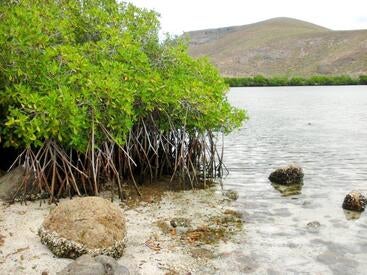高床式の珍しい森林が気候変動を緩和する Unusual forests on stilts mitigate climate change
2022-09-16 カリフォルニア大学リバーサイド校(UCR)

Mangroves in Baja California. (Matthew Costa/UCSD)
マングローブの地下には1,100種類以上の細菌が生息し、さまざまな化学元素を消費・排泄しています。その多くは、酸素が少ない、あるいは全くない極限環境で機能している。しかし、これらのバクテリアは炭素を分解する効率は悪い。
<関連情報>
- https://news.ucr.edu/articles/2022/09/16/mexican-mangroves-have-been-capturing-carbon-5000-years
- https://www.int-res.com/abstracts/meps/v695/p15-31/
バハ・カリフォルニア・スールのマングローブ深層ピートの微生物群集は窒素を循環させるが、古い炭素プールには影響を与えない Baja California Sur mangrove deep peat microbial communities cycle nitrogen but do not affect old carbon pool
M. T. Costa, E. Ezcurra2 O. Aburto-Oropeza, M. Maltz, K. Arogyaswamy, J. Botthoff, E. Aronson
Marine Ecology Progress Series Published:August 25, 2022
DOI:https://doi.org/10.3354/meps14117
ABSTRACT
Mangroves provide important ecosystem services, including storing carbon belowground for millennia. Mangrove carbon storage relies in part on high primary productivity, but essential to the long-lived nature of this storage is the slow rate of microbial decomposition of peat. In this study, we (1) examined how carbon and nitrogen densities and microbial community composition vary with peat age and (2) describe the formation of peat deposits over time. At 4 mangrove sites near La Paz, Baja California Sur, Mexico, we cored the sediments until rejection and obtained 5 cm samples at 20 cm intervals. In these samples, we measured organic carbon (Corg), total nitrogen, δ13C, δ15N, and radiocarbon (14C) age. We observed peat carbon densities of 3.4 × 10-2 ± 0.2 × 10-2 g cm-3, Corg:N ratios of 42 ± 3, and inter-site variation in Corg:N that reflects differing preservation conditions. Recalcitrant organic matter sources and anaerobic conditions leave a strong imprint on peat microbial communities. Microbial community composition and diversity were driven by depth and sediment characteristics, including Corg:N ratio and 14C age. Carbon dating allowed us to reconstruct the accumulation of organic matter over the last 5029 ± 85 yr. Even over this long time scale, though microbes have evidently continuously cycled the peat nitrogen pool, peat carbon density remains effectively unchanged.


